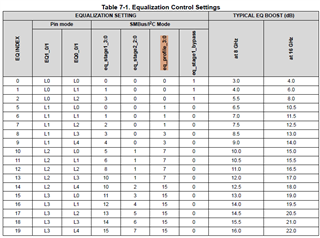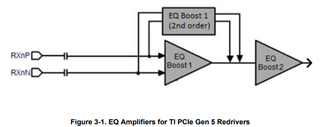Tool/software:
Hi team,
What does eq_profile mean? How does this register affect the PCIe signals?

Best regards,
Shunsuke Yamamoto
This thread has been locked.
If you have a related question, please click the "Ask a related question" button in the top right corner. The newly created question will be automatically linked to this question.
Tool/software:
Hi team,
What does eq_profile mean? How does this register affect the PCIe signals?

Best regards,
Shunsuke Yamamoto
Hi Shunsuke-san,
The "eq_profile" field basically controls the EQ Boost 1 (2nd order) amplifier in the redriver's equalization system. The amplifier setting adjusts the slope of the EQ curve and tends to affect lower frequencies than the other amplifiers.

For most customer environments we recommend using the EQ Index system that organizes combinations of the EQ Boost 1, EQ Boost 2, and EQ Boost 1 (2nd order) amplifiers, so there is usually not a need to adjust the individual amplifier settings. For more details on the equalization system and the amplifiers, you can refer to section 3 of my application note on redriver equalization.
Best,
Evan Su
Hi Evan-san,
Thank you for the reply. Your answer solves my problem! May I ask you an additional question?
Modeflat_gain_2:0 means the deemphasis in the low frequency region?
Best regards,
Shunsuke Yamamoto
Hi Evan-san,
Sorry for asking a lot. May I ask you an additional question?
eq_stage only determines the gain and the frequency of pole, and the value of deemphasis is not determined by eq_stage. is this understanding correct?
Best regards,
Shunsuke Yamamoto
Hi Shunsuke-san,
Modeflat_gain_2:0 means the deemphasis in the low frequency region?

I assume you mean this table - the flat gain setting, also called the DC gain or the VOD, controls the signal amplitude of the output driver. It is called the flat gain because it has approximately the same gain at all frequencies, unlike the EQ amplifiers I discussed previously that have significant gain at only high (x-xx GHz) frequencies. Higher settings of DC gain will increase the signal amplitude, therefore the eye height of the output signal should be larger, but there is a tendency for the eye width of the signal to become lower because the amplifier has more noise. Conversely, lower settings of DC gain will decrease the eye height of the output signal but in some circumstances the lower noise will lead to larger eye width.
In most cases, this can be left at the default 0 dB setting for good or best results.
Also in general there is no specific "de-emphasis" ability in our Gen 5 and Gen 4 redrivers, the EQ amplifiers do not provide negative gain. Setting the flat gain to -2 dB, -4 dB will obviously lead to negative gain at low frequencies, but because it would provide negative gain to high frequencies equally, it does not act like an actual de-emphasis amplifier to my understanding.
eq_stage only determines the gain and the frequency of pole, and the value of deemphasis is not determined by eq_stage. is this understanding correct?
I assume that by "eq_stage" you mean the EQ Stage 1 and EQ Stage 2 amplifiers. As I mentioned, these EQ amplifiers provide positive gain at high frequencies and close to unity gain at low frequencies. The different settings in stage 1 and stage 2 control the slope and peaking of the high-frequency gain to provide more or less boost strength. I assume this is performed at the silicon level by changing the values of variable components in the amplifier networks.
My understanding of a classic de-emphasis procedure is to provide negative gain at low frequencies and close to unity gain at high frequencies, and these amplifiers, along with the other amplifiers in the signal path, do not provide such behavior, so I believe your understanding is correct.
Best,
Evan Su